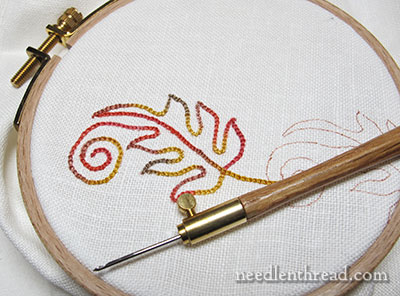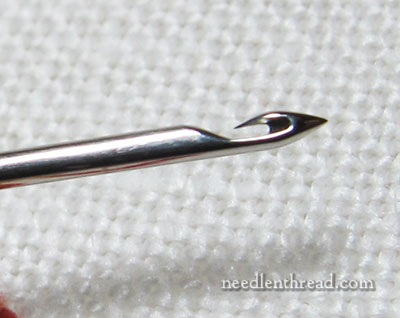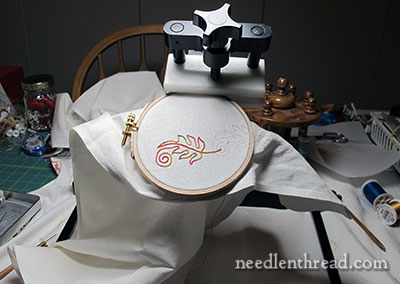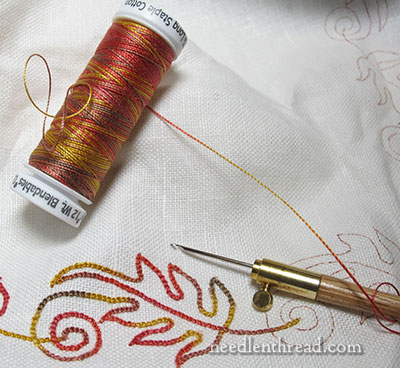This wasn’t supposed to happen.
Yesterday afternoon was all mapped out, scheduled, spoken for, even. Yesterday afternoon, I was supposed to be working on the Mission Rose – finishing up a part, photographing it, preparing an update on it.
But there was so much enthusiastic response on yesterday’s article on tambour embroidery. And enthusiasm and interest like that – well, to a blogger, it’s infectious. You get excited – I get excited. You express interest – my interest increases.
The same thing used to happen in the classroom. Students would get excited about a subject – which would further heighten my excitement – which would lead to an extension on the topic so that we could delve more deeply into it. It’s a normal part of human relationships, I suppose. People tend to feed off each other’s enthusiasm – and that can be a very good thing!
But it can also be very distracting!

I went out to the workroom yesterday afternoon, as I normally do, to get some work done in a number of areas. My first stop was at the table, where my tambour stuff was still set up. Here, I determined to undergo Only Thirty Minutes of practice on the scribble cloth.
But tambour work is a bit addictive. And thirty minutes morphed into an hour.
Or was that an hour and a half?
I kept thinking I would grow bored. Tired. Develop achy muscles or something. But it never happened. I was Good and Stuck.
After fighting myself mentally for a while, I gave in and moved onto a little project that had been seething in my brain ever since I started my practice regime with this damnably addictive hook.
The project idea I’d been musing over involved this autumn leaf border pattern (originally meant for soutache embroidery, its continuous line makes it perfect for tambour work, too), two blank vintage linen hand towels that have been beckoning for embellishment for some time now, some autumnal thread, and the ever-enthralling hook.

This is the culprit, up close, for those who asked to see it. The tip is very sharp, enabling the hook to break through the fabric. The thread slides into the hook area, and is subsequently pulled to the front of the fabric. In the process, there are some twists and turns with the thread and the hook to enable all this to happen smoothly.

And, once I got the autumn leaves underway, this was my set-up, for those who asked to see it. It is less than ideal, but it was hastily conceived in my excitement to get started. I’m using a small hoop because the design is right on the edge of the linen towel. I just shift the hoop when I need to.
My hoop is being held by my frame clamp on my Needlework System 4 table stand. It’s not an ideal set-up for tambour work. The frame clamp gets in the way of the tambour handle.
I’ve got a tambour hoop and stand combination that I bought years ago from Lacis, but the stand is broken down for storage and the hoop (which was not a very good hoop, anyway) is no longer with us. RIP.
For practicing, I used a much larger hoop, and I’ve also used scrap fabric mounted on stretcher bar frames. The key is that you want your fabric stretched tight.
I’ve practiced on several different types of fabric so far, starting with a scrap of silk organza, and then working on cotton muslin, a cotton flour sack towel (a bit fuzzy, but it works), shadow work (handkerchief weight) linen, medium weight linen, and then heavy weight linen.
One reader yesterday suggested using tulle to practice on, so that you can easily see what both of your hands are doing. I think that’s a splendid idea! For practicing, the synthetic tulle sold at the local fabric store is easy to come by and inexpensive.

For thread on this particular experiment, I’m using a spool of Sulky’s Cotton Petite Blendables, in Autumn. Though I’m not a huge fan of variegated threads, I do love them for some applications. I thought these changing fall colors went well with the leaves, echoing the changing of colors and the whole movement of the pattern.
You can find Sulky Cotton Petite Blendables online through Anita’s Little Stitches, or check your local fabric store that carries Sulky products.
The cotton petites work well with the 110 hook (which is the largest hook in the typical set of tambour hook and needles that’s available from Lacis). It glides in and out of the fabric really easily.
We’ll talk resources soon!
And hopefully, I won’t get sucked in by the hook again today….
…but I don’t guarantee it.







I’d love to give that a go!
That tambour hook looks a bit dangerous. And that inner point looks like it would snag on the thread. But I’m sure it all works out very well.
You mention using the cotton thread. I have a Sulky Rayon 2245, almost identical in colors to the one you’re using. Will the hook work with rayon?
I’m so excited about trying this that I ordered the supplies today.
Nice leaves ! and lovely colors ! I hope I’ll be able soon to do seach beautiful things…
I, for one, was also excited to read your post
yesterday about Tambour and was delighted to see you post more info and teaching today. I searched through several you tube videos watching the technique and can’t wait to try this! I also want to learn how they utilize beads and sequins. Thank you for showing all of us this new adventure!
Love the colors…I looked at the YouTube video you linked yesterday—fascinating! I wonder who first invents these techniques?!
What kind of thread did you use beneath (the underside) of the work?
I also wondered how challenging the many curves on your design were to work with the tambour.
Oh my goodness – another obsession begins. Really i blame you Mary – I was so inspired yesterday by the tambour work that I looked for a local class. Now the class I found isnt local – its in London England and I live in Northern Ireland, but its run by two couturier beading experts and for £75 I get a whole day of practically one to one tutoring!!!! Its not til March next year but Im already busting with excitement and am planning a weekend jaunt around it. It is sooooooo comforting to know I’m not the only needlework nerd! Evelyn
p.s. if anyone else in the UK wants details of the course, I’m happy to pass them on.
Thank you so much for writing about tambour embroidery! Keep it coming! I’ve been on the fence about learning to use the tambour needle but now I am looking forward to starting.
You Rock!
Michelle
Alabama
Dear Mary
Well I ordered Tambour needles so I hope to have them soon and I’ve just watched some videos on Soutache embroidery another new sewing method to explore and maybe practice. Oh dear I hope you do get hooked into more Tambour embroidery so that you can show us in more detail how it’s done. I’m still embroidering the little things but I hope to start Tambour soon as I’m so interested in it. I love the colour of the thread so appropriate for this time of year and the pattern is lovely. thanks for showing us more Tambour.
Regards Anita Simmance
Hi Mary! Just wanted to add some info about working on tulle as a project unto itself. Lier Lace is worked on cotton tulle in a frame (like a slate frame). Probably the best know teacher worldwide is Greet Rome-Verbeylen & she occasionally teaches in the US & Canada. There is a basic tutorial of how to start, finish & work a filling posted in English on her website:
http://www.liersekant.be/lierlace.htm
Her traditional motifs are airy & delicate, but her contemporary pieces are truly outstanding. Usual disclaimers! Just a satisfied student.
Adorei
Mary, I have always wondered how tambour work is done. Having read your posts, I found this tutorial which your followers could find useful.
http://embroideryaddict.blogspot.co.uk/2008/08/chain-stich-in-tambour-work.html
Gwendoline
thank you for showing a close up pic of the hook. I watch the video that you linked yesterday, very interesting. The thread is beautiful and the leave looks so nice. Do you start and finish with the thread as you do in your embroideries??? what happen if the thread I started with is not enough and I need to add more?
I wouldn’t worry about plans going astray. It’s cool to share your excitement … great to see more tambour today after the whetting of our appetites yesterday!
It’s really pretty. Is it faster than chainstitch by needle?
I just love the look of that thread with that pattern. Such fun!
G’day there Mary,
This has fascinated me for quite some time but I’ve never tried it. Stored in the back of beyond somewhere I have a hook that I acquired along the line of past specials. I first noticed tambour work mentioned on antique garments and besides the ordinary stitching it seemed to be used for securing sequins. I love your leaf and the thread. That’s a wonderful continuous line pattern. Thanks again.
Cheers, Kath
Hi. I love your site. You are a woman who knows what she is doing & is generous enough to share with all of us. Thank you. My daughter spent 3 months in India & bought me 2 shawls. On e was silk from Varanasi that I had to get a jewellers loupe to be able to see individual threads. The other was a real pashmina encrusted in embroidery done with this method. She also brought home a needle & thread that they use in India. Will have to find it. Do you remember in the 60’s there were floor rugs decorated with this method?
Hi, Peta – the shawls sound beautiful! But I’m afraid I don’t remember the 60’s….wasn’t quite around yet… 🙂 But I think I know what type of rugs you’re talking about. I believe they still enjoy some popularity among the “vintage decorating” crowd. – MC
I love this in the variegated yarn! Like you, I’m not a fan of variegateds but this is a perfect application. I may have to take another look at that fall leaf pattern. Lovely.
For readers in the UK wanting this thread, it’s Gutermann Sulky Cotton 12 over here. Easier to find in quilting shops than embroidery shops, but it’s the same size as pearl cotton 12 – except that the twist goes in the opposite direction to DMC pearl cotton. Both http://www.barnyarns.co.uk and http://www.cottonpatch.co.uk carry it if you can’t get it from a local shop.
Too cool, fyi people I found the hook set on amazo.com for less then 16 $ with free shipping. So I ordered 2. 🙂
If you’re in Europe: you can buy tambour needles and very nice handles in different kinds of wood at http://www.brodely.com (site in English and French). Come to think of it, they probably ship to America, too.
CE QUE JE VEUX LE CROCHER POUR L ACHTER
Hi,
I saw your videos and I think tambour is interesting. I purchase the hook and I downloaded your bird of paradise.
I do punch needle. I have quite a bit of Weaver’s cloth. I was wondering if I could use Weaver’s cloth for tambour?
Thank you
Carla
Hi, Carla – I think that tambour work can be done on practically any fabric, and I think it will work fine on Weaver’s cloth.